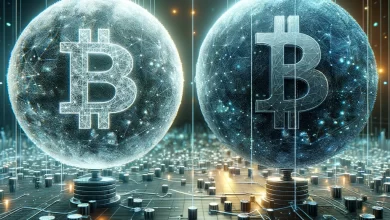CoinJanitor: The Shitcoins’ Highlander out to Kill All Your Shitcoins
Shitcoins, the inglorious remnants of the golden age of crypto, they continue wandering aimlessly like redundant post-apocalyptic robots in a world where they no longer have a purpose or an excuse to exist. They are the bane of every Bitcoin maximalist and a sore on the once pristine body of blockchain tech.
In 2018 a small modest project raised $2.5 million during an ICO. It was called CoinJanitor and its sole declared purpose was to sweep the pestering shitcoins under the rug.
Today Forklog media talked to Marc Kenigsberg, CoinJanitor’s co-founder and Bitcoin’s early adopter and evangelist. How bad are shitcoins for the crypto at large and what can we do to get rid of them for good?
Cleaning Up the Ruckus from the Hype
Constantine: To kick off the interview, let’s talk a bit about what motivates the people behind the CoinJanitor.
Marc: A fundamental belief in Bitcoin. A desire to help it succeed as much as possible and remove waste so that the ecosystem can be healthier and build faster.
I believe that we don’t yet understand the damage that having so many shitcoins will do to the crypto environment and that we have a responsibility as early adopters to try and clean up the mess.
Take an example of sending satellites into space. One day we realized that there’s actually a huge cost to having space debris and junk and we actually have to clean it up. I think the same is going to be proven true in digital space.
Constantine: If I wanted to oversimplify, would I be correct to assume that you guys are basically convinced Bitcoin maximalists who want to outright eliminate as many shitcoins as possible?
Marc: Exactly correct. But not in a hostile way. We want to clean up shitcoins with the holders. Not against.
Constantine: That is an important distinction. Please elaborate.
Marc: The idea isn’t to attack shitcoins. The idea isn’t that we decide whether something should exist or not. The idea is that if a coin doesn’t serve a clear purpose and isn’t fulfilling a use case that is useful to the community at large, then it creates waste.
I premise that waste is bad and ultimately all waste dilutes the market or in some way takes something from Bitcoin, even if it’s marginal. We want to work with the holders and creators of those shitcoins to reduce the number of coins that serve no purpose.
It’s amazing that anyone can create a coin, but we believe there should be some threshold of utility for doing so. Coin should not exist for the sake of existing, the coin should exist for the sake of fulfilling a purpose. It’s difficult to find a purpose outside of Bitcoin, but it can be done arguably.
On Crypto-Custodial Arts
Constantine: So how does it work in a nutshell?
Marc: X coin tried to achieve some sort of aim. It didn’t happen. So all X coin people come together and decide together to remove it from the ecosystem and those people would then onboard CoinJanitor. So CoinJanitor becomes a cleanup mechanism for all the small crypto-currencies that no longer continue. They all get amalgamated into one coin, that’s primary purpose is essentially to be an on-ramp to Bitcoin again.
We will never attack another coin. We don’t believe in hostile takeovers. We only work with the project’s founders and community to clean up. And we don’t believe we are the judge of what is a good coin or not. We only want to clean up coins that recognize the need to be cleaned up.
Ironically, we made it harder for ourselves by trying to do it the nice way. I believe our primary purpose is to educate the market about the need for a cleanup mechanism.
Constantine: Okay, so you don’t engage with those shitcoin communities first, but you actually wait for them to come to you? What’s the procedure? Do the founders plus a large part of the community have to file a formal request? Prove that they hold the overwhelming majority of coins?
Marc: It’s a combination. We get approached by people (which is why the education component is so important). But we also do reach out to founders. We say “we see the situation, we’d like to discuss the possibility of working together with you.” But we won’t say anything to the community until the founder’s onboard.
There have been a couple of cases where the founder wasn’t sure but together we put it up for a vote to the community. We had a community that voted and decided to go ahead with the buyout. We also had an example of a community that voted against the buyout.
Constantine: What about those shitcoin owners who don’t want to participate in a buyout?
Marc: Ultimately we do have people who are unhappy about it. In every buyout there were people who would turn around and say “look, I believed in this coin for whatever reason and I bought it for whatever price but now I’m basically getting something that’s worth less than I hoped.” We try to explain to people the distinction that we weren’t involved in the success or failure of the project. We only came in once it was clear that the project had failed and the founder wanted to move on. We never do anything to affect the project’s chances of success.
In many ways, we chose the harder route to market. But it’s purer.
Constantine: So you’re trying not to be seen as toxic by the shitcoin community.
Marc: Part of our mission is that even if we don’t succeed in doing everything we wanted to, we want to at least create a discussion of the need for cleaning up shitcoins. So part is not to be seen as toxic by that community but part is also in an event that we failed that we leave a message that is pure.
Help Them Go With Dignity
Constantine: Again, to oversimplify, it sounds like you find failed projects that are still struggling to survive and you just give them money so that they shut down?
Marc: In terms of oversimplifying, we find failed projects and we offer them a way to give some value back to the users. In a situation where without us they wouldn’t be able to.
It’s not about just giving them money, it is about restoring some value to the users who are trapped in an asset that value can not be extracted from. We believe in an idea of trapped value. Once a project fails and will no longer be continued, then any value that is left in any form—be it a website, be it a beautiful piece of code, be it a Telegram channel or money on an exchange—it is trapped. It can not ever leave that project.
CoinJanitor gives it a way out. And it’s not altruistic. There is a part of CoinJanitor that is for the good. But we take over the marketing sites, the social accounts and it ultimately helps us to grow and increase our reach.
Most crypto-projects try to onboard individual users. We are onboarding communities. The potential for compounded growth is massive but we really want to make sure the message was clean first.
Constantine: But those people don’t become Bitcoin maximalists after they get bailed out by you, do they? They probably just keep doing what they do, which is launching more shitcoin projects. Don’t you think you’re actually providing shitcoiners with insurance of sorts, help them feel safer, and keep doing what they do?
Marc: Excellent question and I’ll extend it further: are we arguably not even doing worse? Are we arguably not even creating a mechanism where people are rewarded for creating shitty things? And the answer is: we are definitely, unequivocally not.
Firstly, we don’t bail out scams or any projects created in bad faith. The projects that we buyout are projects that tried but didn’t succeed despite trying. That eliminates 99% of the problem.
Secondly, we’re not giving people money. We give them Janitor tokens. And the majority of those go to the community, not founders. The founders get something for their efforts but the reward ultimately needs to go to the community that has tried to build this coin and create a network effect.
And lastly, right now we aren’t nearly big or rich enough to make it worth anyone’s while to do that on purpose.
Down to Earth
Constantine: How much does it cost on average to bail out each shitcoin? Will you eventually run out of tokens?
Marc: Theoretically, yes. But not any time soon. We determine the price that we pay for buyouts based on the model that we’ve built that would allow us to buy out a certain amount of tokens before that happens. And we do have contingency plans.
I’m not going to say exactly what it costs to buy out every project, there’s a variety of factors that we look at when we determine the price. But we do have a range. And the more our token is worth on the exchange the less we would have to pay. So it is an interest over time that goes up. I believe that will happen naturally once we pass a certain amount of buyouts and have some level of the network effect and market exposure. But the current model will allow us to buy out hundreds of tokens before that becomes a real concern.
Constantine: Very briefly, how does it happen technically once everyone has agreed on the clean-up? Do all shitcoin owners get Coinjanitor token airdrop?
Marc: Technically the process is very simple:
- Agreement with the developer.
- Take over technical control and marketing assets.
- Announce swap.
- Swap window for users.
- Burn and shut down.
Constantine: But what if some small rogue group just continues running the shitcoin blockchain? My understanding is that what’s actually happening is not as much killing projects but rather giving those members of its community who want to get out an opportunity to do so. And they can only get a bailout in Janitor tokens. Correct?
Marc: This is where things get more complicated depending on the tech. Proprietary blockchains based off a PoW algorithm and made with a custom wallet we can absolutely shut down. Otherwise, if we are a majority holder and we determine that it will no longer be able to transact then the only routes out for people are to essentially hold to something that is guaranteed never going to function or to fork and do something different with it.
So for ERC token ecosystems, you’re basically right. It’s like giving people a way out. But it also removes at least the majority of a particular coin and from a public view perspective removing the coin from publicly existing. Because we redirect everything and even on Coingecko the coin will be listed as absorbed and recycled by CoinJanitor.
Salvaging
Constantine: From what I’ve heard today, your project is basically salvaging shipwrecks, so to speak. And that is what sustains it. I’m sorry if that’s a mean joke, but CoinJanitor itself in some ways registers as the Mother of all shitcoins. Or like… a shitcoin Highlander. What do you think? Can you pick this assessment apart?
Marc: The shitcoin highlander, that is awesome. There can be only one! I love the image of Christopher Lambert and Kurgan having it out with a broom and a shitcoin sword. It’s a great question. For the most part, I can take the assessment apart but there is some validity to what you’re saying as well.
First, if we remove 50, 100, or 500 of shitcoins and replace it with 1 (assuming we’re a shitcoin as well) then we have actually reduced dilution and improved the circumstance in the market. Just by virtue of doing that we’ve fulfilled something a shitcoin can’t which sets us above shitcoins. A shitcoin with a higher purpose that reduces the number of shittier shitcoins is by definition something more than a shitcoin.
Second, our stated purpose is an onramp back to Bitcoin. Shitcoins try to create a use case that requires a coin to exist, our primary purpose to exist is to move back to Bitcoin. If we fulfill our purpose and allow those shitcoin holders to migrate across and back to Bitcoin then we have by definition done more than a shitcoin can and restored some market aspect back to Bitcoin.
We’re not in this only completely altruistically but if by virtue of existing we leave the market with a discussion of how shitcoins need to be cleaned up, we’ve already fulfilled our purpose in existing.
You’re right in asking the question, there are some superficial parallels and arguably CoinJanitor is a shitcoin collector which kind of makes it the “mother of all shitcoins” but for the reasons stated above, as well as others, we’re completely different.
Constantine: What are CoinJanitor’s achievements so far? How many shitcoins salvaged? What are some other achievements you’re proud of?
Marc: The fact that we still exist 2+ years later having gone through this bear market is an achievement. We’ve already bought out 5 or 6 different coins and onboarded their users. No one in history ever bought out or taken over two other currencies, we’re the first coin in history to have done that multiple times.
But this whole shitcoin discussion and the amount of projects where people talk about shitcoins and focus on value and salvaging only exists because we started it. This whole idea of salvaging projects and a lot of the burning ideas, a lot of what is being discussed today in terms of the shitcoin economy is the direct result of the ideas we came up with, and you can see it in the reproduction of the language and things like this.
We have introduced ideas of repurposing the shitcoins and burning them into the market, which was our primary purpose.
Look Into the Future
Constantine: What’s CoinJanitor’s endgame?
Marc: Medium-term is to keep doing what we’re doing and accelerate the buyout process. We’ve passed the proof of concept and established the precedent to be able to do it. Now it’s really to put in place the infrastructure to do it at scale, to increase the market exposure.
Long-term is to become an effective mechanism for liquidating shitcoins and ultimately the basis for mergers and acquisitions in the crypto space. Maturing from a non-profit and educational resource into a profitable company, which can support all the people who’ve helped us get this far.
Follow us on Twitter and Facebook and join our Telegram channel to know what’s up with crypto and why it’s important.
Source: forklog.media
View original post





